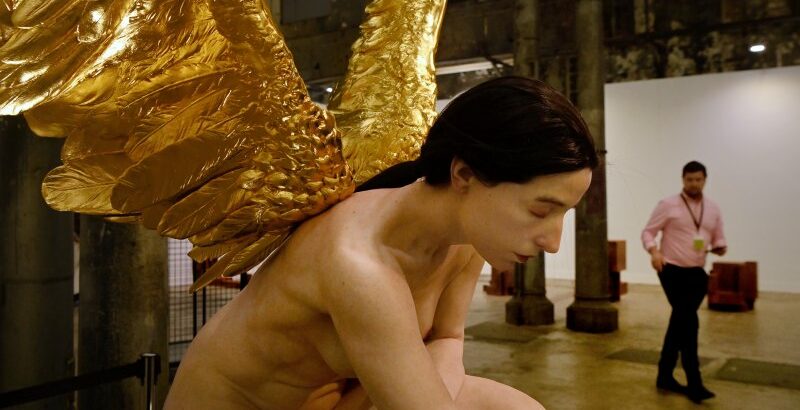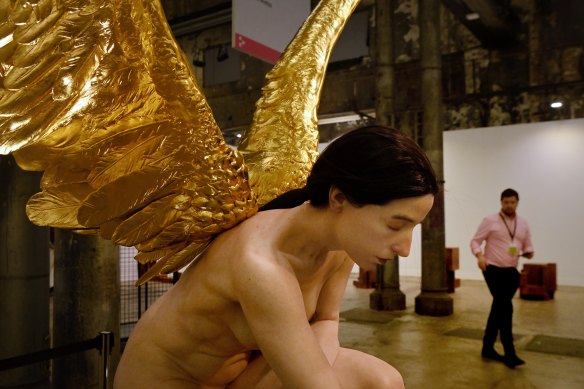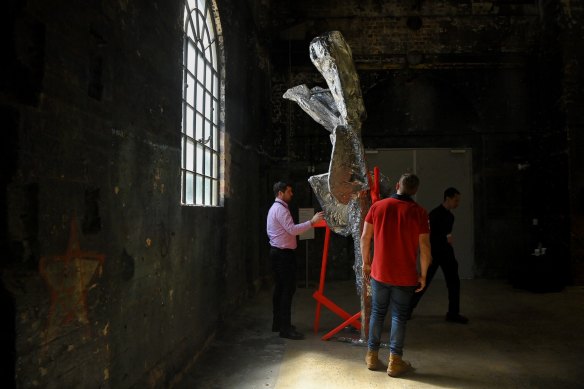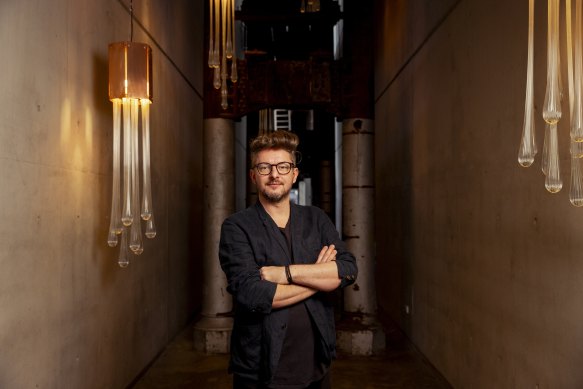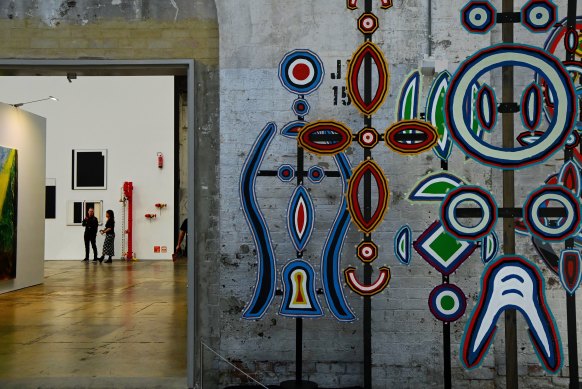Save articles for later
Add articles to your saved list and come back to them any time.
Contemporary art is forever making statements about political and social justice, but there’s no escaping the fact that art fairs are massive commercial enterprises in which artworks are, first and foremost, commodities.
Is there anything wrong with that? No, not unless you are making work that is a strident denunciation of the capitalist system. In the art fairs we find a pervasive emptying out of critical engagement. The truly “important” works are the ones that sell.
This is arguably a more honest approach than we find in museums, where we are expected to admire so many dull, worthy things because they inculcate the correct values, or are made by the right kind of people.
Sam Jinks’ Iris – The Messenger.Credit: Kate Geraghty
So, two cheers for mere commerce: 96 galleries, four days, one massive party in the former industrial space that is now Carriageworks. Add in a busy program of talks and performances, and 13 major installations, and Sydney Contemporary is looking conspicuously like one of those things this city adores – an event. We’ve seen it happen with Sculpture by the Sea, Vivid and, most recently, the Women’s World Cup.
There is every possibility of attracting huge audiences, raising the profile of the art market among a population that has viewed it, historically, as an elite and obscure pursuit. For the experienced organisers of the fair, it’s not really possible to lose. They act as landlords for participating galleries that pay hefty sums to take part, and they earn income from admissions, which look set to increase again this year. For the galleries, it’s a calculated gamble. Many of them don’t expect to cover costs, but still feel it’s essential to take part. It’s almost touching to see how excited they get when they make an early sale.
For the major international galleries in the leading fairs, it’s business-as-usual to make millions of dollars’ worth of sales within the first hour, although one assumes that many of these sales were agreed beforehand. In Australia, the stakes are much lower. Compared with Europe, America and much of Asia, Australian art is inexpensive.
Molten Slayer by Nabilah Nordin is moved into position at Syndey Contemporary.Credit: Kate Geraghty
One of the underlying functions of Sydney Contemporary is to help bring Australia in line with the rest of the world, developing a more lucrative, competitive market. As Australia has more than 130 billionaires, there’s no shortage of disposable income in the country, but a great reluctance to spend it on art. The only way to get these tight-fisted tycoons to consider plunging into the art market is through the education of taste, the cultivation of social status, or the blunt realisation that one can make money buying works of art and later selling them on through auction houses.
If I tried to discuss all the galleries and highlights of this year’s fair, this column would swiftly degenerate into a laundry list. Nevertheless, I’ll attempt a few sweeping impressions, allowing for the fact that when I visited the fair it was still so early that fluoro vests were obligatory fashion items.
All galleries covet a position in the first row, capturing viewers as they walk through the door. Utopia Art has made the most of the opportunity with a jaw-dropping display of western and central desert painting; Vermilion Art, next door, has made a feature of two large works by Chinese master Yin Zhaoyang. Alcaston’s stall is dominated by a huge work by Sally Gabori, while Gow Langsford has a wall-sized abstract painting by Grace Wright – balanced by a small Picasso plate, hiding around the corner.
Artist Alex Seton with his installation Trying to Reinvent Themselves and Their Universe.Credit: Dominic Lorrimer
Some of the best booths are devoted to solo exhibitions, the pick of the bunch being Roslyn Oxley9 Gallery’s display of bark paintings and poles by Dhambit Mununggurr. These works, in startling shades of blue, are like Aboriginal art from outer space, although they actually hail from Yirrkala, the Arnhem Land community that keeps producing one extraordinary artist after another. To confirm this observation, Toby Meagher at Michael Reid Galleries showed me three impressive metal engravings by emerging Yolngu artist Gaypalani Wanambi, the daughter of the late Wukun Wanambi.
There’s also something going on in the north-west, as Emilia Galatis of EG Projects demonstrates with a very strong show of paintings by Corban Clause Williams and engraved pearl shells by Garry Sibosado. It’s not unusual for Indigenous art to dominate this fair but the range and quality of work this time acts as a powerful endorsement of the industry. The established secondary dealers such as D’Lan Davidson and the late Tim Klingender have dependably good selections, but one of the real surprises comes from Brisbane-based dealers A Secondary Eye, who are hosting a survey of sculptured ceremonial objects by Roy Wiggan (1930-2015) of the Kimberley.
It’s a museum show disguised as a commercial proposition. Wiggan’s work also features among the 13 artists who have contributed free-standing installations, although the show-stealer, predictably, is Sam Jinks, with a hyperreal sculpture called Iris – the Messenger, which features a naked woman with huge, golden wings gazing into a reflective pool. Alex Seton’s chandeliers, tucked away in a corridor, are a surprising departure for this artist, known as a stone carver. Jenna Lee shows how to hold a wall with a series of simple, diamond-shaped works on paper and Sarah Smuts-Kennedy has contributed a kind of energy tent, made from large sheets of paper covered in coloured abstract markings.
One welcomes new additions to the fair, such as Nancy Nan’s Redbase, which has been based in Sydney for more than a year, showing new art from China, Indonesia and South Korea. There are also three Japanese galleries, each with work that should intrigue visitors. Wollongong is represented by the enterprising Egg & Dart; New Zealand by a range of leading galleries, including Starkwhite, Paulnache and Robert Heald.
Sydney Contemporary is at Carriageworks until Sunday.Credit: Kate Geraghty
Easily the most internationally significant inclusion this year is Galleria Continua, with branches in San Gimignano, Beijing, Les Moulins, Havana, Rome, Sao Paulo, Paris and Dubai. They are showing a suite of sculptures by British superstar Antony Gormley.
I’d recommend a visit to the fair just to see one new painting by James Morrison at the Darren Knight Gallery. Good Government (2023), with its pink eagles and carefully inscribed ducks, has taken the artist many months to finish, earning him the dealer’s accolade of greatest delight and greatest frustration. It was worth the wait.
I could keep going, but I hope I’ve said enough to whet your appetites. Sydney Contemporary continues today and tomorrow. Just don’t – under any circumstances – imagine you’ll find a parking spot.
Sydney Contemporary 2023 is at Carriageworks until Sunday.
Most Viewed in Culture
From our partners
Source: Read Full Article
